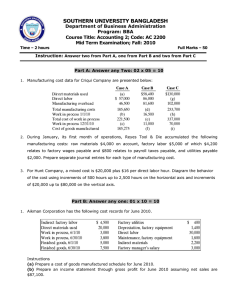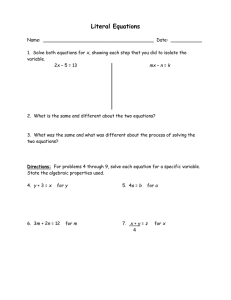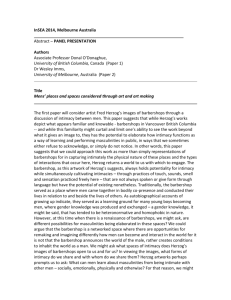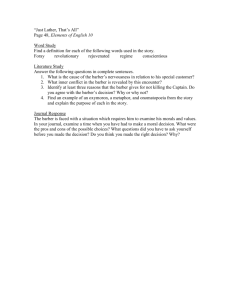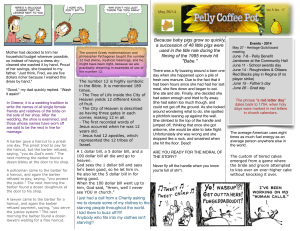Practice Quiz on Chapter 8 True-False Questions
advertisement
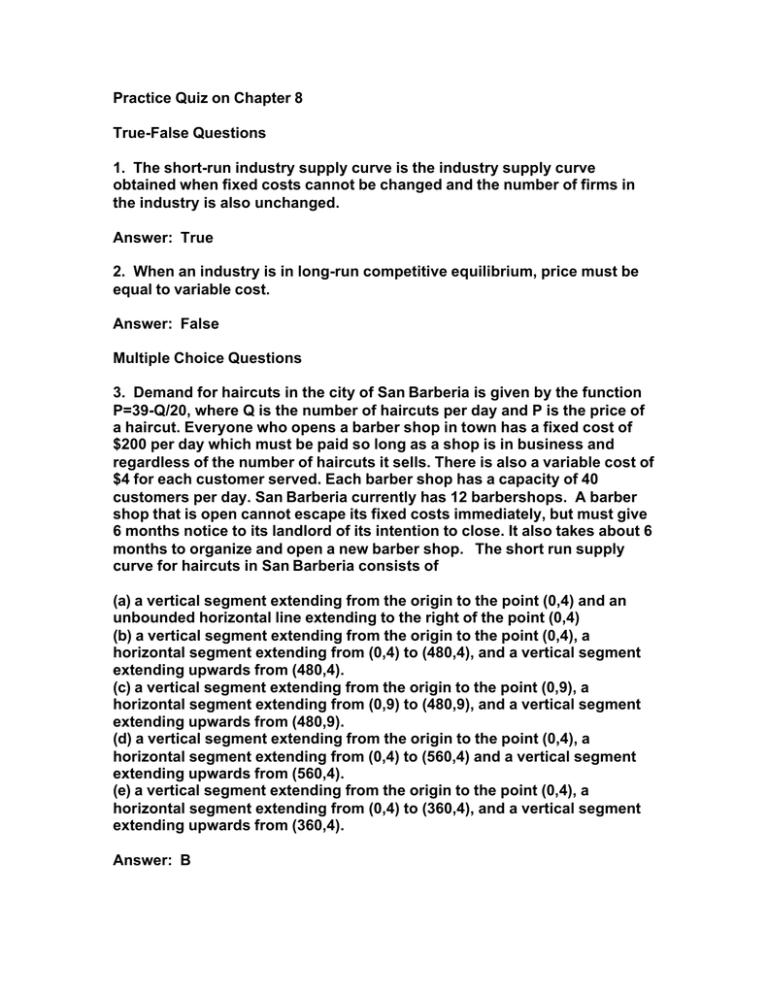
Practice Quiz on Chapter 8 True-False Questions 1. The short-run industry supply curve is the industry supply curve obtained when fixed costs cannot be changed and the number of firms in the industry is also unchanged. Answer: True 2. When an industry is in long-run competitive equilibrium, price must be equal to variable cost. Answer: False Multiple Choice Questions 3. Demand for haircuts in the city of San Barberia is given by the function P=39-Q/20, where Q is the number of haircuts per day and P is the price of a haircut. Everyone who opens a barber shop in town has a fixed cost of $200 per day which must be paid so long as a shop is in business and regardless of the number of haircuts it sells. There is also a variable cost of $4 for each customer served. Each barber shop has a capacity of 40 customers per day. San Barberia currently has 12 barbershops. A barber shop that is open cannot escape its fixed costs immediately, but must give 6 months notice to its landlord of its intention to close. It also takes about 6 months to organize and open a new barber shop. The short run supply curve for haircuts in San Barberia consists of (a) a vertical segment extending from the origin to the point (0,4) and an unbounded horizontal line extending to the right of the point (0,4) (b) a vertical segment extending from the origin to the point (0,4), a horizontal segment extending from (0,4) to (480,4), and a vertical segment extending upwards from (480,4). (c) a vertical segment extending from the origin to the point (0,9), a horizontal segment extending from (0,9) to (480,9), and a vertical segment extending upwards from (480,9). (d) a vertical segment extending from the origin to the point (0,4), a horizontal segment extending from (0,4) to (560,4) and a vertical segment extending upwards from (560,4). (e) a vertical segment extending from the origin to the point (0,4), a horizontal segment extending from (0,4) to (360,4), and a vertical segment extending upwards from (360,4). Answer: B 4. What is the short run equilibrium price of a haircut in San Barberia? (a) $15 (b) $5 (c) $4 (d) $9 (e) $20 Answer: A 5. If initially, conditions in San Barberia are as described in the previous questions, and if in the long run there is free entry and exit from the industry, competitive theory predicts that in the long run in San Barberia the number of barber shops (a) would decrease and each would sell more haircuts per day. (b) would decrease and each would continue to operate at full capacity. (c) would increase. (d) would remain the same, but each would sell more haircuts. (e) would remain the same and each would continue to operate at full capacity. Answer: C 6. Suppose that 5 new barbershops open in San Barberia and none of the old barbershops close. In the new short run equilibrium the price of a haircut (a) will be $9 and all barbershops will make zero profits. (b) will be $10 and all barbershops will make positive profits. (c) will be $8 and all barbershops will make losses. (d) will be $5 and all barbershops will make losses. (e) will be $6 and all barbershops will make losses. Answer: D 7. In long run equilibrium in San Barberia, the number of barber shops (a) is 15 and the price of a haircut is $9. (b) is 17 and the price of a haircut is $5. (c) is 12 and the price of a haircut is $15. (d) is 13 and the price of a haircut is $13 (e) is 16 and the price of a haircut is $9. Answer: A 8. Suppose that in San Barberia, the number of barber shops had adjusted so that both the number of barber shops and the price of a hair cut were in long run equilibrium. After long run equilibrium had been reached without any taxes, the city unexpectedly imposed a tax on barbers, requiring them to pay a $2 sales tax on every haircuts they sold. What does economic theory predict would be the short run effect of the tax on the price of a hair cut? (a) The price would rise by $2. (b) The price would rise by $1. (c) The price would remain the same as before the tax. (d) The price would rise by $.50. (e) The price would rise by $1.50. Answer: C 9. How would the new $2 tax on hair cuts affect profits of barber shops in the short run? (a) Because prices rise by the amount of the tax, there would be no effect. (b) Profits would fall, but would remain positive after the tax. (c) Profits would fall to zero after the tax. (d) In the short run, after the tax is imposed, each firm would have a loss of $40. (e) In the short run, after the tax is imposed, each firm would have a loss of $80. Answer: E 10. In long run equilibrium, imposing the $2 tax on haircuts in San Barberia would cause the price of haircuts (a) to rise by $1.50 and the number of barbershops to increase by 1. (b) to rise by $1 and the number of barbershops to stay constant. (c) to rise by $2 and the number of barbershops to stay constant. (d) to rise by $2 and the number of barbershops to decrease by1. (e) to rise by $2 and the number of barbershops to decrease by 3. Answer: D
